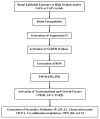Is oxidative stress, a link between nephrolithiasis and obesity, hypertension, diabetes, chronic kidney disease, metabolic syndrome?
- PMID: 22213019
- PMCID: PMC5683185
- DOI: 10.1007/s00240-011-0448-9
Is oxidative stress, a link between nephrolithiasis and obesity, hypertension, diabetes, chronic kidney disease, metabolic syndrome?
Abstract
Epidemiological studies have provided the evidence for association between nephrolithiasis and a number of cardiovascular diseases including hypertension, diabetes, chronic kidney disease, metabolic syndrome. Many of the co-morbidities may not only lead to stone disease but also be triggered by it. Nephrolithiasis is a risk factor for development of hypertension and have higher prevalence of diabetes mellitus and some hypertensive and diabetic patients are at greater risk for stone formation. An analysis of the association between stone disease and other simultaneously appearing disorders, as well as factors involved in their pathogenesis, may provide an insight into stone formation and improved therapies for stone recurrence and prevention. It is our hypothesis that association between stone formation and development of co-morbidities is a result of certain common pathological features. Review of the recent literature indicates that production of reactive oxygen species (ROS) and development of oxidative stress (OS) may be such a common pathway. OS is a common feature of all cardiovascular diseases (CVD) including hypertension, diabetes mellitus, atherosclerosis and myocardial infarct. There is increasing evidence that ROS are also produced during idiopathic calcium oxalate (CaOx) nephrolithiasis. Both tissue culture and animal model studies demonstrate that ROS are produced during interaction between CaOx/calcium phosphate (CaP) crystals and renal epithelial cells. Clinical studies have also provided evidence for the development of oxidative stress in the kidneys of stone forming patients. Renal disorders which lead to OS appear to be a continuum. Stress produced by one disorder may trigger the other under the right circumstances.
Figures



Similar articles
-
Stress oxidative: nephrolithiasis and chronic kidney diseases.Minerva Med. 2013 Feb;104(1):23-30. Minerva Med. 2013. PMID: 23392535 Review.
-
The association of nephrolithiasis with hypertension and obesity: a review.Am J Hypertens. 2008 Mar;21(3):257-64. doi: 10.1038/ajh.2007.62. Epub 2008 Jan 24. Am J Hypertens. 2008. PMID: 18219300 Review.
-
Nephrolithiasis and hypertension: possible links and clinical implications.J Nephrol. 2014 Oct;27(5):477-82. doi: 10.1007/s40620-014-0068-x. Epub 2014 Feb 28. J Nephrol. 2014. PMID: 24577680 Review.
-
24-h urine metabolic profile: is it necessary in all kidney stone formers?Int Urol Nephrol. 2018 Jul;50(7):1243-1247. doi: 10.1007/s11255-018-1902-1. Epub 2018 Jun 6. Int Urol Nephrol. 2018. PMID: 29876775
-
Reactive oxygen species, inflammation and calcium oxalate nephrolithiasis.Transl Androl Urol. 2014 Sep 1;3(3):256-276. doi: 10.3978/j.issn.2223-4683.2014.06.04. Transl Androl Urol. 2014. PMID: 25383321 Free PMC article.
Cited by
-
Phytochemical composition analysis and evaluation of in vitro medicinal properties and cytotoxicity of five wild weeds: A comparative study.F1000Res. 2020 Jun 2;9:493. doi: 10.12688/f1000research.22966.1. eCollection 2020. F1000Res. 2020. PMID: 32676186 Free PMC article.
-
HydroZitLa inhibits calcium oxalate stone formation in nephrolithic rats and promotes longevity in nematode Caenorhabditis elegans.Sci Rep. 2022 Mar 24;12(1):5102. doi: 10.1038/s41598-022-08316-8. Sci Rep. 2022. PMID: 35332173 Free PMC article.
-
Analysis of altered microRNA expression profiles in proximal renal tubular cells in response to calcium oxalate monohydrate crystal adhesion: implications for kidney stone disease.PLoS One. 2014 Jul 1;9(7):e101306. doi: 10.1371/journal.pone.0101306. eCollection 2014. PLoS One. 2014. PMID: 24983625 Free PMC article.
-
A prospective case-control study on the evaluation of oxidative stress in renal stone formers.Urolithiasis. 2024 Jan 2;52(1):18. doi: 10.1007/s00240-023-01514-7. Urolithiasis. 2024. PMID: 38165517
-
Association Between Dietary Selenium Intake and Kidney Stones Disease Among Patients with Metabolic Syndrome: A Cross-Sectional Study from the NHANES Database.J Multidiscip Healthc. 2024 Dec 31;17:6255-6264. doi: 10.2147/JMDH.S496819. eCollection 2024. J Multidiscip Healthc. 2024. PMID: 39759084 Free PMC article.
References
-
- Pearle MS, Calhoun EA, Curhan GC. Urologic diseases in America project: urolithiasis. J Urol. 2005;173:848. - PubMed
-
- Stamatelou KK, Francis ME, Jones CA, et al. Time trends in reported prevalence of kidney stones in the United States: 1976–1994. Kidney Int. 2003;63:1817. - PubMed
-
- Soucie JM, Coates RJ, McClellan W, et al. Relation between geographic variability in kidney stones prevalence and risk factors for stones. Am J Epidemiol. 1996;143:487. - PubMed
-
- Obligado SH, Goldfarb DS. The association of nephrolithiasis with hypertension and obesity: a review. Am J Hyper-tens. 2008;21:257. - PubMed
Publication types
MeSH terms
Grants and funding
LinkOut - more resources
Full Text Sources
Other Literature Sources
Medical
Miscellaneous

